Jul 23, 2019 | celebration, coins, commemorative, dollar, policy, US Mint

The dual-dated Bicentennial reverse designs are still very popular amontst collectors
The act forbade the striking of silver dollars for five years ending an experiment with the striking of Peace Dollars in 1964. There are rumors that at least one 1964-D Peace exists despite the U.S. Mint’s insistence that all of the coins were melted.
Finally, the act made all coins and currency produced in the United States and specific bank issues as legal tender, which reversed the demonetization of the Trade Dollar in 1867.
The Coinage Act of 1965 marks the dividing line between “classic” and “modern” coinage.
After fifty-four years of modern coinage, there continues to be collectors and dealers who turn up their noses at modern coins.
Although the stories behind many of the classic issues are interesting, modern coins provide a diversity that is meaningful and affordable for the average collector.
The first coin of the modern era that had a public impact was the dual-dated coins with the reverses honoring the nation’s bicentennial. The bicentennial was a two-year celebration preceded by three years of hype and prep. When the coins were released, many people searched their change, looking for the coins. It was the first time in many years that half-dollar and large dollar coins circulated in significant numbers since finding them in change was exciting.
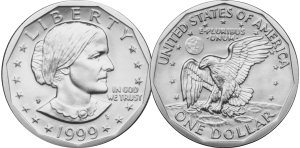
The Susan B. Anthony dollar was less than successful because it was confused with a quarter
The most successful program of the modern era was the 50 State Quarters program. The program started strong with a lot of interest. Unfortunately, a downturn in the economy and the television hucksters overselling the potential value of the series turned away a lot of potential collectors.
As the success of the 50 State Quarters program grew, Congress passed laws to create several other circulating commemoratives. The programs include the Westward Journey Nickels, Abraham Lincon Bicentennial cents, and the Native American $1 coin program using the golden-colored planchets of the Sacagawea dollar.
The modern era saw the return of the commemorative coin programs. Some were very popular, like the 2001 American Buffalo Commemorative Coin and 2014 National Baseball Hall of Fame Commemorative Coin programs. There were less popular coins, but none had flopped as bad as the 2013 Girl Scouts of the USA Centennial Silver Dollar.
Unlike previous commemorative coin laws, modern laws help the U.S. Mint limit the time these coins can remain on sale. It also limits their production to one year.
Finally, the modern era has given us the bullion coin series. It started with the American Silver Eagle program that was created to provide a way for the United States government to sell off silver saved in the Defense National Stockpile. As a result, the U.S. Mint has used the program to experiment with different finishes, including burnished and reverse proof.
Congress passed the Gold Bullion Coin Act of 1985 a few months later after being lobbied by the gold mining interests. This law created the American Eagle Gold Bullion Program.

2013-W American Buffalo gold reverse proof obverse
After 54 years there are a lot of exciting choices for the modern collector. And this does not consider the collection of errors or varieties, like the three types of 1972 Eisenhower dollars or the wide versus narrow lettering on the reverse of the 1999 Lincoln cent.
It is past the time for the numismatic community to embrace the collection of modern coins more than it has. There may be few modern coins that are worth thousands of dollars, but they are available to capture the interest of potential collectors. After all, how many of us started collecting by searching pocket change.
Jul 16, 2019 | celebration, coins, commemorative, history
“We choose to go to the moon. We choose to go to the moon in this decade and do the other things, not because they are easy, but because they are hard, because that goal will serve to organize and measure the best of our energies and skills, because that challenge is one that we are willing to accept, one we are unwilling to postpone, and one which we intend to win, and the others, too.”
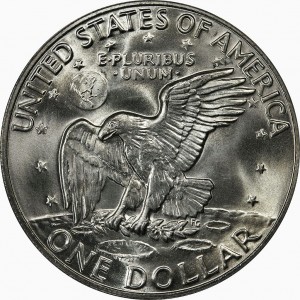
Eisenhower Dollar Reverse featuring the Apollo 11 mission insignia
Kennedy’s vision was accomplished by the Apollo 11 crew of Commander Neil Armstrong, Command Module Pilot Michael Collins, and Lunar Module Pilot Edwin “Buzz” Aldrin along with the thousands of support people on Earth. A little more than eight years after Kennedy made it the nation’s policy, Apollo 11 launched from Cape Kennedy on July 16, 1969.
From within the capsule attached to the top of the Saturn V launch vehicle, a rocket once described as a giant Roman candle, the rocket roared to life to lift the three pioneers into the final frontier. Even though the liftoff occurred at 9:32 AM in Florida, it was watched worldwide regardless of the local time.
Four days later, on Sunday, July 20, 1969, the world held its collective breath as the Lunar Module (LM), call-sign Eagle, was guided to the moon’s Sea of Tranquility and landed at 4:18 PM Central Time. Relief came when Neil Armstrong transmitted a message to Mission Control in Houston:
“Houston, Tranquility Base here. The Eagle has landed.”
CAPCOM (Capsule Communicator) Charles Duke’s response summed up the feel of those of us on Earth as he stumbled a bit at the beginning:
“Roger, Twan– Tranquility, we copy you on the ground. You got a bunch of guys about to turn blue. We’re breathing again. Thanks a lot.”
According to the official schedule, Armstrong and Aldrin were supposed to get five hours of sleep. Realizing that it was unlikely they would be able to sleep, the crew prepared for the first walk on the moon’s surface.
Six and a half hours after landing, after Walter Cronkite and the CBS News team showed models as to how Armstrong will descend from the LM, pull the D-Ring to activate the camera, Armstrong left the LM and went down the latter. He pulled the D-Ring, and the world watched his progress. Just before reaching the surface of the moon, Armstrong uncovered a plaque mounted on the LM that read:
Armstrong looked at the surface and described the moon’s dust as “very fine-grained” and “almost like a powder.” Then with a short jump, he left the bottom rung of the ladder and was standing on the surface of the moon.
“That’s one small step for [a] man, one giant leap for mankind.”
Over the years, there has been a debate about whether Armstrong included the word“a” in the statement. That is not what was heard at the time, and modern examinations of the audio tapes neither confirm or deny the claim. Regardless of what he said, Neil Armstrong was the first man to walk on the surface of the moon, a little more than eight years since President Kennedy said it was his goal.

Apollo 11 Flown MS66 NGC Sterling Silver Robbins Medallion, Serial Number 241, from The Armstrong Family Collection (Courtesy of Heritage Auctions)
The practice of carrying Fliteline medals started in 1965 with the flight of Gemini 3, NASA’s first manned mission in the Gemini program. In 1968, the Robbins Company of Attleboro, Mass. was contracted to produce the Fliteline medals starting with Apollo 7.
It is reported that 480 of these 28mm medals were carried aboard Apollo 11.
According to Heritage Auctions, the most paid for a mission flown Robbins Medal was medal #241, a silver medal graded MS66 by NGC, that sold for $112,500 (including buyer’s premium) on November 1, 2018. It was sold with a Statement of Provenance signed by Armstrong’s sons as being once owned by Neil Armstrong. The provenance likely accounts for its high price.
Jul 4, 2019 | celebration
 Independence Day in the United States is a celebration of the formal breakup with the British monarchy. But like a lot of political decisions on this side of the pond, it was a decision that caused a lot of debate. For example, during the discussion on whether to declare independence, Maryland was one of four colonies to hold out. The others were New York, Pennsylvania, and South Carolina.
Independence Day in the United States is a celebration of the formal breakup with the British monarchy. But like a lot of political decisions on this side of the pond, it was a decision that caused a lot of debate. For example, during the discussion on whether to declare independence, Maryland was one of four colonies to hold out. The others were New York, Pennsylvania, and South Carolina.
Here are five other historical notes about the declaration:
- The preamble of what would become the beginning of the Declaration of Independence passed on May 15, 1776.
- On June 11, 1776, the “Committee of Five” was appointed to draft a declaration. Committee members were John Adams of Massachusetts, Benjamin Franklin of Pennsylvania, Thomas Jefferson of Virginia, Robert R. Livingston of New York, and Roger Sherman of Connecticut. They completed the draft on June 28, 1776.
- The Continental Congress debated the draft on July 1-2, 1776. New York and South Carolina were still holdouts, and the two Deleware representatives were deadlocked. This lead to the historical ride of Caesar Rodney, who rode 80 miles to Philadelphia to vote in favor of independence.
- After Thomas Jefferson made the final agreed upon corrections to the document, the Continental Congress approved the draft on July 4, 1776, with 12 votes. Only New York abstained since they did not have the authority from their government.
- The final signatures were added on August 2, 1776. Since New York approved the resolution of independence on July 10, the New York delegation is included amongst the signatures.

Although we celebrated the birth of the nation in 1776, the new country was not recognized until 1783 when the two nations signed the Treaty of Paris.

May 27, 2019 | celebration
 The first recorded organized public recognition of the war dead occurred on May 1, 1865, in Charleston, South Carolina. On that day, Freedmen (freed southern slaves) celebrated the service of the 257 Union soldiers buried at the Washington Race Course (now Hampton Park). They labeled the gravesite “Martyrs of the Race Course.” African Americans continued that tradition and named the celebration Decoration Day.
The first recorded organized public recognition of the war dead occurred on May 1, 1865, in Charleston, South Carolina. On that day, Freedmen (freed southern slaves) celebrated the service of the 257 Union soldiers buried at the Washington Race Course (now Hampton Park). They labeled the gravesite “Martyrs of the Race Course.” African Americans continued that tradition and named the celebration Decoration Day.
Memorial Day took on national significance following World War I when the nation began to recognize all those who gave the ultimate sacrifice during all conflicts. By the end of World War II, most of the celebrations were renamed to Memorial Day. Memorial Day did not become an official holiday until 1967 with the passage of the Uniform Holidays Act (sometimes referred to as the Monday Holiday Bill). Under the law, Memorial Day was set to the last Monday in May, changing it from the traditional May 30th.
The modern Memorial Day is a holiday celebrating the lives of those sacrificed in defense of the United States and its ideals at home and abroad. Today, we honor the memories of those who paid the ultimate sacrifice, from the days of the revolution to the conflicts in around the world, so that I have the freedom to write this blog and you can read and share it amongst your friends.

SPECIAL REMEMBRANCE: New Mexico Sen. John D. Pinto, a former World War II Navajo Code Talker, died on Friday, May 24, 2019. Pinto was one of the 400 native Navajo people who learned the code based on the Navajo language. It was used to communicate among the troops in the Pacific Theater during World War II. After the war, Pinto became a teacher and then a state senator in 1977. He was 94.
IMAGE: New Mexico Gov. Michelle Lujan Grisham and Sen. John D. Pinto (via Twitter)
Apr 21, 2019 | celebration, coins, news
 National Coin Week is celebrated every third week of April to bring awareness to those neat little metal items jingling in your pocket as something that makes a fun collectible. This year the numismatic community is going all out to get you to look at your change with the Great American Coin Hunt. Why? Because change hunting is how many of us started. While finding silver coins may be rare (or is it?), there are still collectible coins in circulation.
National Coin Week is celebrated every third week of April to bring awareness to those neat little metal items jingling in your pocket as something that makes a fun collectible. This year the numismatic community is going all out to get you to look at your change with the Great American Coin Hunt. Why? Because change hunting is how many of us started. While finding silver coins may be rare (or is it?), there are still collectible coins in circulation.
Round Table Trading is a nationwide organization of coin dealers. Members of the Round Table have committed to placing collectible coins into circulation. Coins will range from Indian Head Cents to Morgan Dollars and everything in between. You may want to examine that dime you just received in change carefully because it could be a Mercury Dime that was struck by the U.S. Mint from 1916-1946.

I already own a 1909-S VDB Lincoln Cent, but I will be looking, too!
Also, look for coins with silver and gold stickers on them. If you find one, bring it to a coin dealer and redeem it for something worth more. Silver stickers can be traded for silver coins, and gold stickers will get you a gold coin. There are rumors that some dealers will redeem a gold sticker for a Saint-Gaudens Double Eagle ($20) gold coin worth more than $2,500.
The U.S. Mint is also participating by releasing the first-ever circulating coins with the “W” mint mark to indicate that the coins were minted at the facility in West Point, New York. In 2019, the U.S. Mint will add 10 million quarters, two million for each of the 2019 America the Beautiful Quarter Series coins, into circulation. After being struck at West Point, 1 million of each quarter will be sent to the mints at Philadelphia and Denver to be mixed in with the circulating coins that will be delivered to the Federal Reserve.
Although you might think that producing 10 million coins is not rare, consider that the U.S. Mint will produce nearly 1 BILLION quarters in a year making it about 1-percent of the Mint’s quarters production.
Finally, the American Numismatic Association is holding a 2069 coin design challenge and an Online Trivia Challenge. Visit the ANA website daily for the rules and a new daily question.
And now the news…

April 16, 2019
GREENWICH – A high school senior from Greenwich is bringing a very modern approach to the ancient pastime of coin collection. Christian Hartch, 18, was given a small collector's book for pennies by his father, Greg, when he was 5. He's been obsessed with numismatics, the study of coins, ever since, and brought his enthusiasm to thousands of followers on YouTube.  → Read more at greenwichtime.com
→ Read more at greenwichtime.com

April 18, 2019
Byzantine ruler created the 438 Theodosian law code, which collected the thousands of imperial laws of the sprawling empire and officially made Jews second-class citizens  → Read more at timesofisrael.com
→ Read more at timesofisrael.com

April 18, 2019
A new dollar coin designed to commemorate 50 years of homosexual rights has sparked a dual backlash — from both members of Canada’s LGBT community and from a social conservative group.  → Read more at cbc.ca
→ Read more at cbc.ca

April 18, 2019
A gold and silver coins hoard was found by four treasure hunters with a metal detector in a field in Buckinghamshire and includes 12 rare full gold coins from the time of the Black Death.  → Read more at dailymail.co.uk
→ Read more at dailymail.co.uk

April 19, 2019
2019-04-19T17:51:29.479634Z  → Read more at wmur.com
→ Read more at wmur.com

April 20, 2019
EASTON — Take a moment to really count your change next week, you might be surprised to find some unusual and collectible coins.As part of National  → Read more at tauntongazette.com
→ Read more at tauntongazette.com
Jan 1, 2019 | administrative, celebration

As we begin a new year, we should look forward to better times for our hobby, our nation, and our world. I wish you and yours a Happy and Healthy 2019 and hope that you find the key coin of your dreams!
-

-
2019 Native American $1 coin — American Indians in the Space Program.
-

-
2019 Apollo 11 50th Anniversary Commemorative Silver Dollar
Dec 25, 2018 | administrative, celebration
Whether you celebrated Chanukah

“10 Zuz” Silver Hanukkah Gelt — ca. 19th Century from Eastern Europe (Image courtesy of Moreshet Auctions)
Observed Festivus, for the rest of us

FDR dime struck on a nail (stand in for Festivus Pole) (Imaget courtesy of Heritage Auctions)
Having a Merry Christmas

Reverse of the 2009 Latvia 1 Lat coin with the Christmas Tree on the reverse (Image courtesy of Latvijas Banka via Numista)
Or will begin celebrating Kwanzaa
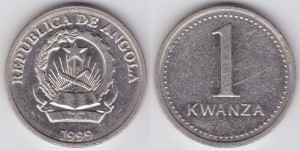
1999 Angola 1 kwanza as a stand-in to help celebrate Kwanzaa (Image courtesy of the Currency Wiki)
I hope you are having a joyous holiday season!
 On a personal note, my wife and I just left Boomer at the vet hospital. Boomer is 12 years old and celebrated his 12th anniversary with us on December 2. Since we were never able to have children, Boomer was our first four-legged child. It will be hard to imagine life without Boomer so we are hoping for the best.
On a personal note, my wife and I just left Boomer at the vet hospital. Boomer is 12 years old and celebrated his 12th anniversary with us on December 2. Since we were never able to have children, Boomer was our first four-legged child. It will be hard to imagine life without Boomer so we are hoping for the best.
Sep 13, 2018 | Baltimore, celebration, coins, commemorative, US Mint
On this day 204 years ago, Francis Scott Key was awakened aboard the HMS Tonnant in Baltimore Harbor to see the tattered, but still present flag flying over Fort McHenry. Today’s LOOK BACK talks about the history of that day and, rather than talking about the legislation, add a little information about the Star Spangled Banner commemorative coin.
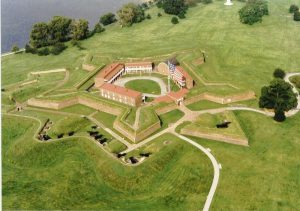
Fort McHenry (via Wikipedia)
On Skinner’s way to meet Vice Admiral Alexander Cochrane, Rear Admiral Sir George Cockburn, and Major General Robert Ross on the HMS Tonnant, he stopped at the home of noted lawyer Francis Scott Key and asked for his assistance.
Col. Skinner and Key were welcomed by the British command on September 13, 1814 and was invited to stay for dinner. After secure the release of Dr. Beanes but were not allowed to return to Baltimore. The British felt that Col. Skinner and Key had learned too much about the British forces. Col. Skinner, Key, and Dr. Beanes were provided guest accommodations on the HMS Tonnant.
The Battle of Baltimore began after dinner and raged overnight through the next morning. On September 14, 1814, when the smoke cleared, Key saw the Stars and Stripes still flying over Fort McHenry. Following the battle. Col. Skinner, Key, and Dr. Beanes were allowed to return to Baltimore on their own boat. During the trip, Key wrote a poem entitled “The Defence of Fort McHenry”
On September 20, 1814, Key had the poem published in the newspaper Patriot. After publication, Key set the poem to the tune of John Stafford Smith’s “The Anacreontic Song,” a popular drinking song written for London’s Anacreontic Society. The combination was renamed “The Star Spangled Banner.”
“The Star Spangled Banner” was first recognized by the Navy in 1889. In 1916, President Woodrow Wilson signed an executive order to recognize “The Star-Spangled Banner” as the national anthem. Finally, President Herbert Hoover singed a congressional bill officially making the song the United State’s National Anthem (36 U.S.C. §301).
In 2012, the U.S. Mint issued two coins as part of the Star-Spangled Banner Commemorative Coin Program (authorized by Public Law 111-232). The $5 gold coin “depicts a naval battle scene from the War of 1812, with an American sailing ship in the foreground and a damaged and fleeing British ship in the background” on the obverse and “the first words of the Star-Spangled Banner anthem, O say can you see, in Francis Scott Key’s handwriting against a backdrop of 15 stars and 15 stripes, representing the Star-Spangled Banner flag.”
-

-
2012 Star-Spangled Banner Gold Commemorative Obverse depicts a naval battle scene from the War of 1812, with an American sailing ship in the foreground and a damaged and fleeing British ship in the background. Designed by Donna Weaver and engraved by Joseph Menna.
-
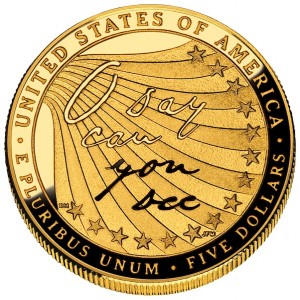
-
2012 Star-Spangled Banner Gold Commemorative Reverse Depicts the first words of the Star-Spangled Banner anthem, O say can you see, in Francis Scott Key’s handwriting against a backdrop of 15 stars and 15 stripes, representing the Star-Spangled Banner flag. Designed by Richard Masters and engraved by Joseph Menna.
The obverse of the silver $1 coin “depicts Lady Liberty waving the 15-star, 15-stripe Star-Spangled Banner flag with Fort McHenry in the background.” The reverse shows the waving of a modern American Flag.
-

-
2012 Star-Spangled Banner Silver Commemorative Obverse depicts Lady Liberty waving the 15-star, 15-stripe Star-Spangled Banner flag with Fort McHenry in the background. Designed by Joel Iskowitz and engraved by Phebe Hemphill.
-

-
2012 Star-Spangled Banner Silver Commemorative Reverse depicts a waving modern American flag. Designed by William C. Burgard III and engraved by Don Everhart.
The official launch of the 2012 Star-Spangled Banner Commemorative Coin Program was launched at Fort McHenry in Baltimore. You can read about that launch here.
You can read the original article
here.
All coin images are courtesy of the U.S. Mint.
Jul 4, 2018 | celebration
We, therefore, the Representatives of the united States of America, in General Congress, Assembled, appealing to the Supreme Judge of the world for the rectitude of our intentions, do, in the Name, and by Authority of the good People of these Colonies, solemnly publish and declare, That these United Colonies are, and of Right ought to be Free and Independent States; that they are Absolved from all Allegiance to the British Crown, and that all political connection between them and the State of Great Britain, is and ought to be totally dissolved; and that as Free and Independent States, they have full Power to levy War, conclude Peace, contract Alliances, establish Commerce, and to do all other Acts and Things which Independent States may of right do. And for the support of this Declaration, with a firm reliance on the protection of divine Providence, we mutually pledge to each other our Lives, our Fortunes and our sacred Honor.
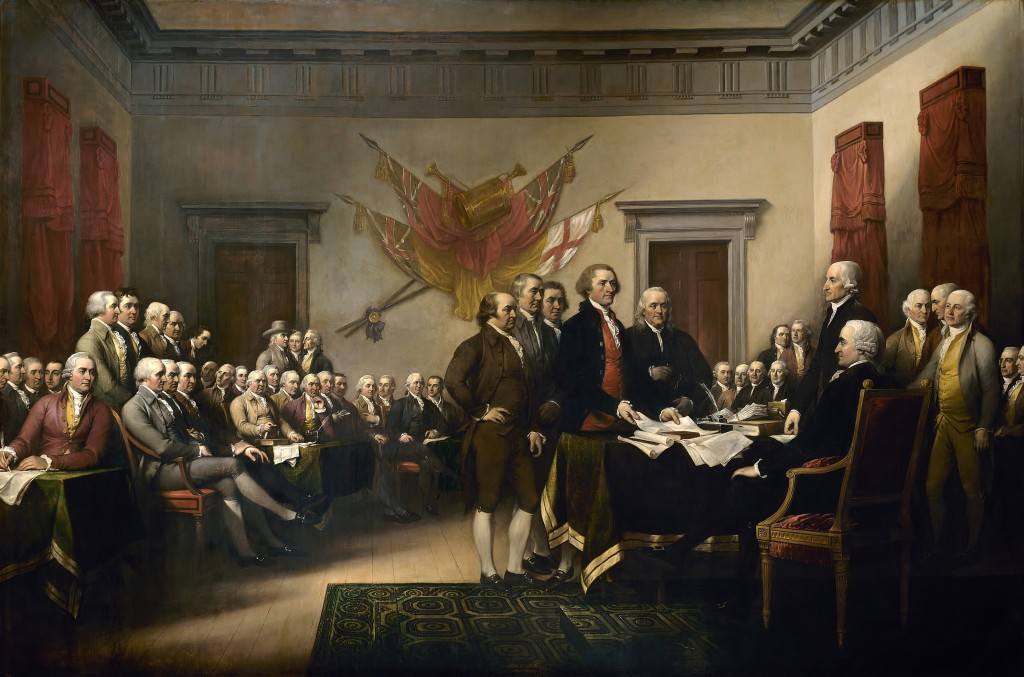
John Trumbull’s Declaration of Independence hangs in the U.S. Capitol Rotunda. It was used as the model for the reverse of the $2 Federal Reserve Note.
Jul 1, 2018 | Canada, celebration
On July 1, 1867, the British colonies of Canada, Nova Scotia, and New Brunswick were joined together as a single kingdom within the British Empire then known as the Dominion of Canada. It was the first step to gaining full independence from Great Britain. Canada would gain its full independence in 1931.
Often referred to as Canada’s Birthday, July 1 was celebrated as Dominion Day until 1982 when it was renamed as Canada Day. Celebrations around Canada fully recognize this day as being the one where Canada is celebrated. Canadians, both in the country and around the world will raise a Molson’s in honor of O Canada!
To our friends from north of our border, and yes, contrary to what others might say you are our friends…
HAPPY CANADA DAY!
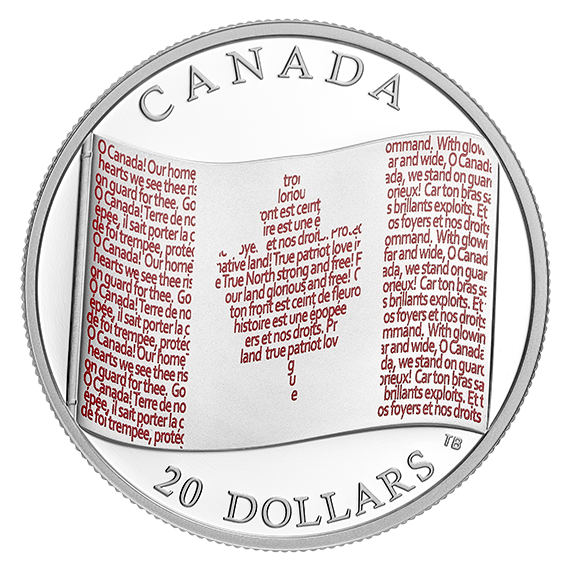
2018 Canadian Flag with coloured micro-sized letters that put O Canada into art!
Coin image courtesy of the Royal Canadian Mint.













 → Read more at
→ Read more at 














